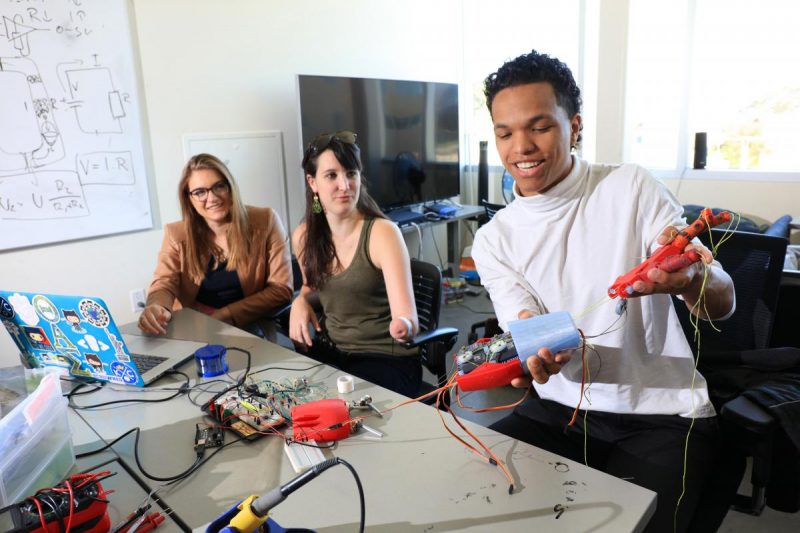Featured
Game Research Lab at CSUMB combines technology and practical research

By Scott Roark
CSUMB
June 21, 2017 — Seaside, CA
(Photo above: (L-R): Alyssia Goodwin, Morgan Juran, and Brandon Woodard demonstrate a low-cost, prosthetic arm and hand. Juran, who was born missing the lower part of her left arm, can move the robotic “fingers” by flex sensors. Source: CSUMB)
The tables of electronics and circuits only hint at the research being conducted
Walk into the Game Research Lab at CSUMB and look around. The tables of electronics and circuits only hint at the research being conducted.
Things get more interesting upon further examination, with prosthetic arms placed inconspicuously on shelves. In another room, virtual reality goggles lie next to sensors on tripods. A large whiteboard, resembling an air hockey table, is placed in the corner. A row of computers border a wall, joysticks sitting next to keyboards.
It looks like every kid’s ideal game room. But the research projects here could be an indicator of technology that will transform lives and the world.
Krzysztof Pietroszek, an assistant professor in the CSUMB School of Computing & Design, is the director of the Game Research Lab, which he founded last year. Pietroszek and a fellow colleague Christian Eckhardt oversee daily activities of the lab, utilized by many students for Capstone projects. Others come to tinker and explore. Being a part of the lab is not a for-credit class. Rather, it’s a resource for students that want to push boundaries and explore potential technological breakthroughs.
To Pietroszek, it’s more than experimenting. His main interest is utilizing technology to assist people with disabilities in practical, cost-effective ways. In addition, technology like virtual reality (VR) can make education widely accessible regardless of geographic location – and can serve as a training tool for fields such as medicine and architecture.
One of the more intriguing projects at the game design lab is the development of a low-cost prosthetic arm. The arm is 3D printable, meaning it’s created with successive layers of hard plastic material under computer control, sourced from data out of a digital model.
The arm is controlled by flex sensors that are attached to the patient. It’s been tested by CSUMB student Morgan Juran, a computer science major, who was born missing the lower part of her left arm right below the elbow. In the lab, Eckhardt and his students attach the prosthetic arm via sensors to the end of Juran’s missing limb. She can then move the “fingers” of the robotic hand secured at the end of the prosthetic arm by using muscle movements in her left arm.
Continue reading article here: https://csumb.edu/magazine/new-reality
Tagged CSUMB







